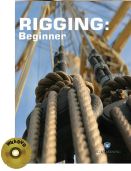Trade and Industrial Education

Rigging: Beginner comprehends various diverse practical and visual skills with knowledge of specialized materials and techniques. Rigging is the action of designing and installing the equipment, in the preparation to move objects. A team of riggers design and install the lifting or rolling equipment needed to raise, roll, slide or lift objects such as with a crane or block and tackle. This book will introduce the knowledge and skills for those studying and/or working in construction industry to interpret and convey information in response to workplace requirements.
About this Book
The information in this book consists of competencies that workers must achieve to enable them to perform tasks such inspecting, and installing rigging gears and guiding crane operators in construction sites or other locations.
About the Rigging Industry
A rigger sets up machinery and secures it in place, or reeves rope through a pulley or a block and tackle. He splices either fiber rope or wire rope, sets up hoists, attaches the end of a crane’s hoist to cargo awaiting movement and guides the cargo through narrow spaces or into storage. When done with the job, he takes down the block, line or hoist and stows it for later use. Typically, riggers are high school graduates or have an equivalency certificate. The rigger is the entry-level position on an oil rig. The riggers are employed in construction and manufacturing. In both of these environments, the rigger assists in movement of heavy equipment and cargo by calculating the size and type of sling required for a particular lift, selecting the slings to lift the load, attaching the slings to the load and assisting in controlling the load as it is lifted by a crane. Riggers also select pulleys or blocks used for lifts, tie knots to secure cargo and maintain rope as required. Riggers then secure all slings and ropes and store them as required. Riggers are needed in the construction of ships, as well, meaning they are employed by shipyards. Aboard ships, rigging is part of seaman’s duties, where it is called marlinspike seamanship. Riggers work in the entertainment industry as well, moving heavy scenery elements and other equipment. Riggers use common hand tools, such as wrenches, hammers and screwdrivers. They also use specialty tools, such as rigging vises and marlinspikes, long pointed metal spikes used to open the threads of wire ropes in the course of splicing wire rope. Riggers also use a fid, a wooden spike, to open the threads of fiber ropes, in the process of splicing the rope. Rigger’s training is usually short-term training on the job, although several manufacturers of rigging equipment and riggers’ supplies offer formal training that includes the theory and practice of rigging.